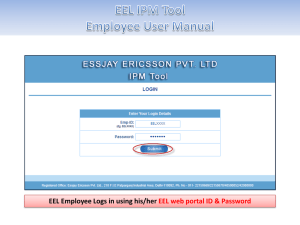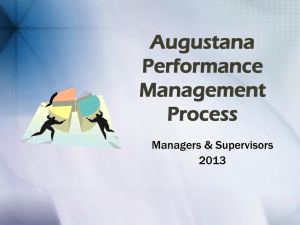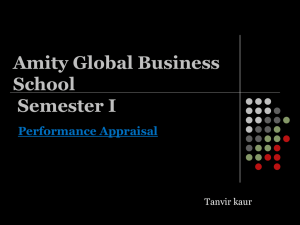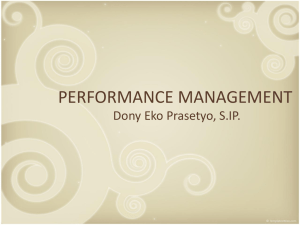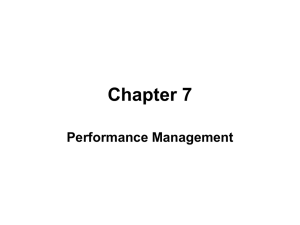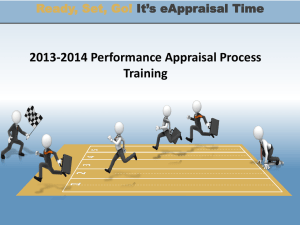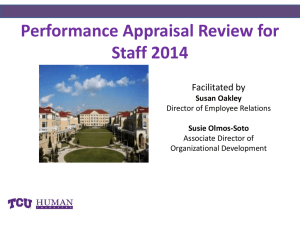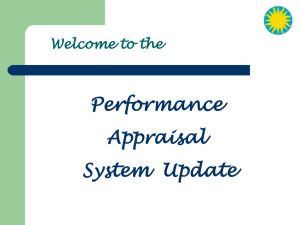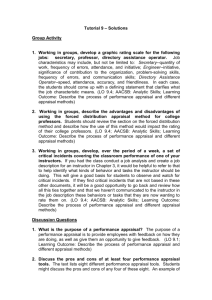“Closing the loop” and improving student learning
advertisement
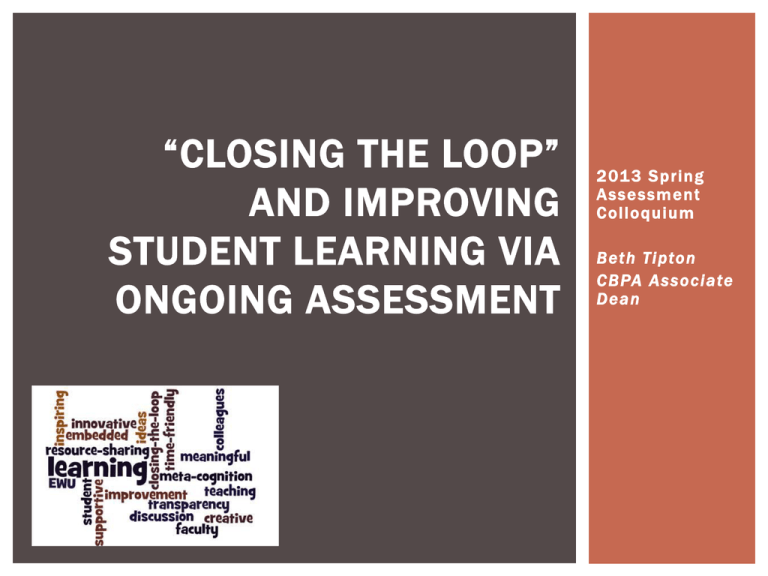
“CLOSING THE LOOP” AND IMPROVING STUDENT LEARNING VIA ONGOING ASSESSMENT 201 3 Spring Assessment Colloquium Beth Tipton C BPA Assoc iate Dean KEEPING IT SIMPLE WHILE CLOSING THE LOOP 201 3 Spring Assessment Colloquium Beth Tipton C BPA Assoc iate Dean ENVIRONMENT AACSB BAB AACSB MBA Other specialized accreditations (PA, PLAN, HSAD) NWCCU Majors and Certificates Writing Initiative Math Initiative CONTINUAL IMPROVEMENT Goal of assessment OLD PROCESS A S S E S S M E N T B Y C O O R D I N AT O R S F O R M A J O R S O N LY PLAN SLOs for courses, programs and GenEd are identified for assessment ACT DO Assessment shows SLOs as either (1) being met (increase benchmark) or (2) not being met (improve course, program or GenEd) Courses, programs and GenEd in which these SLOs are embedded are taught TEST These SLOs are assessed and the results are reported to the relevant instructors, units and accreditations OLD PROCESS A S S E S S M E N T B Y C O O R D I N AT O R S F O R M A J O R S O N LY 1 Learning Outcome Goal Students should possess the knowledge and skills needed to effectively manage the compensation function. 2 Objective This year’s focus is on performance appraisal. Students will be expected to demonstrate their knowledge of the research literature regarding performance appraisal formats/methods. Students will also be expected to demonstrate their knowledge of the research literature regarding performance appraisal rating errors and biases. 7 Observations from Summary Data 1) 82% of students achieved an average of 3.0 or higher with regard to “Performance Characteristic” # 1. 2) 85% of students achieved an average rating of 3.0 or higher with regard to “Performance Characteristic” # 2. 3 Strategy/Method of Measurement Multiple choice questions regarding performance appraisal formats/methods and performance appraisal rating errors and Biases will be developed by HR faculty. These questions will be embedded in Exam #2 of HUMR 427 (Compensation). 4 Performance Characteristics 1. Knowledge of the research literature regarding performance appraisal formats/meth ods. 2. Knowledge of the research literature regarding performance appraisal rating errors and biases. 8 Conclusions about Student Learning Students exceeded the expectation standards for both “Performance Characteristics.” 9 Actions Recommended Based on Observations Based on the assessment data that was gathered, no major changes or actions are required. The students have demonstrated that they have adequate knowledge of the research literature regarding both performance appraisal methods, and performance appraisal rating errors and biases. However, HUMR instructors should continue to ‘stay on top’ of recent research in the area of performance appraisal. 5 Scoring Levels 5 = Excellent (90-100) 4 = Above Average (80-89) 3 = Competent (7079) 2 = Below Average (60-69) 1 = Poor (0-59) 10 Plan and Timetable for Taking Action HUMR instructors should continue to keep abreast of new research in the area of performance appraisal by reading the most recent issues of Personnel Psychology and the Journal of Applied Psychology. 6 Expectation Standard 80% of students will achieve an average rating of 3.0 or higher. 11 Overall Reflection on Assessment The objectives are important for the HRM program, and assessment of these objectives should continue. CONFLICTING DEFINITIONS BAB AACSB “program” Core Majors Faculty Courses Courses NWCCU “program” REDESIGN GOALS Intervention for improvement at the lowest level necessary Gathers actionable data Closes the loop automatically Empowers the faculty to make some changes immediately Simple and efficient Minimizes the impact on faculty Can be cycled quickly if necessary Scales to any level Flexes with differing pedagogical approaches NEW PROCESS COURSE-EMBEDDED ASSESSMENT DO Course is taught ADJUST Changes to course or program are made TEST Assigned Goal is evaluated NEW PROCESS COURSE-EMBEDDED ASSESSMENT Ethics Multiculturalism and Global Awareness Teamwork and Collaboration Understanding Financial Statements Data Analysis Skills MGMT 326 MGMT 423 MGMT 326 ACCT 251 DSCI 346 MGMT 423 MKTG 310 MGMT 490 FINC 335 OPSM 330 POTENTIAL GOALS Economics, Communication Skills, UNASSESSED COURSES Information Systems, Business Law… ACCT 261, ACCT 252, DSCI 245, ECON 201, and MISC 311, “EACH INSTRUCTOR BECOMES HIS/HER OWN BENCHMARK” Strategy of the new process NEW PROCESS COURSE EMBEDDED ASSESSMENT Initial planning phase – at the beginning of the first quarter Goals being assessed AACSB program-level goal (as assigned) NWCCU major-level goal (when appropriate) Course learning objective (from syllabus if appropriate) Course details for tracking purposes Instructor Course Section Quarter Assessment plan Faculty are encouraged, but not required to coordinate with colleagues when establishing measures Description of the measures being used Actual instrument and rubrics How will the measure be converted to a percentile score MEASUREMENT Student B Student C •1 •2 •3 •1 •2 •3 •1 •2 •3 GRADES ASSESSMENT Student A NEW PROCESS COURSE EMBEDDED ASSESSMENT Reporting phase – at the end of the first quarter Assessment How many students completed the measure How many students earned > 75% on the measure What percentage of students earned > 75% If appropriate, submit three examples (excellent, typical, worst) Improvement plan for the next cycle Given what you have learned and observed, please identify specific changes you will make in this course in order to improve student performance on this goal. For each change that will be implemented, please briefly explain why you believe it will address the problem effectively.” “Is there anything our core program can do differently to better prepare students for success on this learning goal?” NEW PROCESS COURSE EMBEDDED ASSESSMENT Reporting phase – at the end of the following quarters Assessment How many students completed the measure How many students earned > 75% on the measure What percentage of students earned > 75% If appropriate, submit three examples (excellent, typical, worst) What happened between cycles (improve, stay the same, decline) “Did the changes you implemented based upon the last assessment lead to improvement? Explain.” Improvement plan for the next cycle “Given what you have learned and observed, please identify specific changes you will make in this course in order to improve student performance on this goal. For each change that will be implemented, please briefly explain why you believe it will address the problem effectively.” “Is there anything our core program can do differently to better prepare students for success on this learning goal?” POSSIBLE FINDINGS INSTRUCTOR-LEVEL One section is underperforming relative to the others Identify specific issues that challenged that section Monitor future assessments for those challenges COURSE-LEVEL One course underperforming relative to the other Identify course-specific design/implementation issues Develop possible solutions by faculty in discipline to be implemented in all sections of the course Reassess for efficacy next time the course is taught PROGRAM-LEVEL Both courses underperforming on assigned goal Develop possible solutions in Undergraduate Business Program Committee with relevant faculty Reevaluate assessment measures for efficacy in evaluating changes to be made Reassess as soon as possible once changes are implemented WHERE WE ARE NOW First quarter “benchmarking” DO TEST ADJUST Second quarter “loop closing” DO TEST ADJUST WHAT NEXT? AACSB BAB AACSB MBA Other specialized accreditations NWCCU Majors and Certificates Writing Initiative Math Initiative Scale this process
